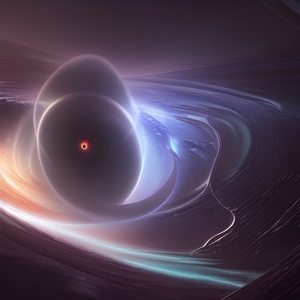OutSky
Jedi Master
Have science (re-)discovered the variability of physicality? The C’s tell us that the “variability of physicality” discovered by Eistein was suppressed by the PTB. In the article bellow is stated that a black hole presents several mass at the same time, as if it behave like some type of quantum particle.
News Release 30-Oct-2022
Uncovering the massive quantum mysteries of black holes
Peer-Reviewed Publication
University of Queensland

image: An illustration of a mass-quantised black hole, created using NightCafe Creator AI. view more
Credit: NightCafe Creator AI
Bizarre quantum properties of black holes – including their mind-bending ability to have different masses simultaneously – have been confirmed by University of Queensland physicists. A UQ-led team of theoretical physicists, headed by PhD candidate Joshua Foo, ran calculations that reveal surprising black hole quantum phenomena.
“Black holes are an incredibly unique and fascinating feature of our universe,” Mr Foo said.
“They’re created when gravity squeezes a vast amount of matter incredibly densely into a tiny space, creating so much gravitational pull that even light cannot escape.
“It’s a phenomenon that can be triggered by a dying star.
“But, until now, we haven’t deeply investigated whether black holes display some of the weird and wonderful behaviours of quantum physics.
“One such behaviour is superposition, where particles on a quantum scale can exist in multiple states at the same time.
“This is most commonly illustrated by Schrödinger’s cat, which can be both dead and alive simultaneously.
“But, for black holes, we wanted to see whether they could have wildly different masses at the same time, and it turns out they do.
“Imagine you’re both broad and tall, as well as short and skinny at the same time – it’s a situation which is intuitively confusing since we’re anchored in the world of traditional physics.
“But this is reality for quantum black holes.”
To reveal this, the team developed a mathematical framework allowing us to “place” a particle outside a theoretical mass-superposed black hole. Mass was looked at specifically, as it is a defining feature of a black hole, and as it is plausible that quantum black holes would naturally have mass superposition.
Research co-supervisor, Dr Magdalena Zych, said that the research in fact reinforces conjectures raised by pioneers of quantum physics.
“Our work shows that the very early theories of Jacob Bekenstein – an American and Israeli theoretical physicist who made fundamental contributions to the foundation of black hole thermodynamics – were on the money,” she said.
“He postulated that black holes can only have masses that are of certain values, that is, they must fall within certain bands or ratios — this is how energy levels of an atom works, for example.
“Our modelling showed that these superposed masses were, in fact, in certain determined bands or ratios – as predicted by Bekenstein.
“We didn’t assume any such pattern going in, so the fact we found this evidence was quite surprising.
“The universe is revealing to us that it’s always more strange, mysterious and fascinating than most of us could have ever imagined.”
The research has been published in Physical Review Letters.
Also the abstract by Physical Review
Abstract by Physical Review Letters (Published 28 October 2022)
Abstract
We present a new operational framework for studying “superpositions of spacetimes,” which are of fundamental interest in the development of a theory of quantum gravity. Our approach capitalizes on nonlocal correlations in curved spacetime quantum field theory, allowing us to formulate a metric for spacetime superpositions as well as characterizing the coupling of particle detectors to a quantum field.
We apply our approach to analyze the dynamics of a detector (using the Unruh-deWitt model) in a spacetime generated by a Banados-Teitelboim-Zanelli black hole in a superposition of masses. We find that the detector exhibits signatures of quantum-gravitational effects corroborating and extending Bekenstein’s seminal conjecture concerning the quantized mass spectrum of black holes in quantum gravity. Crucially, this result follows directly from our approach, without any additional assumptions about the black hole mass properties.[/URL]
